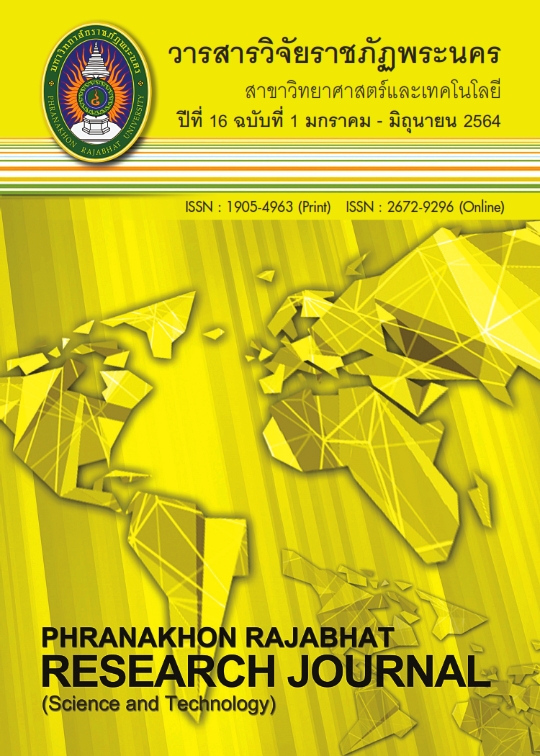การพัฒนาผลิตภัณฑ์คุกกี้สิงคโปร์จากผงรำข้าวไรซ์เบอร์รี่โดยใช้ชอร์ตเทนนิ่งน้ำมันรำข้าวทดแทนเนยขาว
คำสำคัญ:
คุกกี้สิงคโปร์, รำข้าวไรซ์เบอร์รี่, น้ำมันรำข้าว, เนยขาวบทคัดย่อ
การวิจัยนี้มีวัตถุประสงค์เพื่อพัฒนาผลิตภัณฑ์คุกกี้สิงคโปร์จากผงรำข้าวไรซ์เบอร์รี่ทดแทนแป้งสาลี และการใช้ชอร์ตเทนนิ่งน้ำมันรำข้าวทดแทนเนยขาวในผลิตภัณฑ์คุกกี้สิงคโปร์จากผงรำข้าวไรซ์เบอร์รี่ ทำการประเมินคุณภาพทางประสาทสัมผัส คุณภาพทางกายภาพ และองค์ประกอบทางเคมี พบว่า ผลิตภัณฑ์คุกกี้สิงคโปร์จากแป้งรำข้าวไรซ์เบอร์รี่ทดแทนแป้งสาลี ร้อยละ 20 ได้รับคะแนนความชอบโดยรวม จากผู้บริโภคสูงสุด (p≤0.05) และมีองค์ประกอบทางเคมี ดังนี้ เถ้าร้อยละ 1.74±0.04 โปรตีนร้อยละ 7.81±0.11 ไขมันร้อยละ 27.63±0.03 คาร์โบไฮเดรต ร้อยละ 58.80±0.05 ค วามชื้นร้อยละ 4.02±0.03 ใยอาหาร 9.37 กรัม และให้พลังงาน 515.11 กิโลแคลอรี่ ต่อ 100 กรัม ผลการตรวจวิเคราะห์คุณภาพทางกายภาพ พบว่า ผลิตภัณฑ์มี ค่าสี L* a* b* เท่ากับ 41.24±0.03 5.66±0.01 และ 11.97±0.04 ตามลำดับ คุกกี้สิงคโปร์ที่มีการทดแทนแป้งสาลีด้วยผงรำข้าวไรซ์เบอร์รี่ เมื่ออัตราส่วนของผงรำข้าวไรซ์เบอร์รี่มากขึ้น มีค่าการแตกหัก ค่าความแข็ง และค่าความกรอบเพิ่มขึ้น (p≤0.05) แต่ค่าอัตราการแผ่กระจายไม่แตกต่างกัน (p>0.05) ผลการใช้ชอร์ตเทนนิ่งน้ำมันรำข้าวทดแทนเนยขาวในผลิตภัณฑ์คุกกี้สิงคโปร์ พบว่า ผลิตภัณฑ์คุกกี้สิงคโปร์ มีคุณภาพทางกายภาพไม่แตกต่างจากสูตรควบคุม
เอกสารอ้างอิง
Ananchok, N. (2018). Trans fat. Retrieved from https://www.pharmacy.mahidol.ac.th/th/knowledge/
article/436. (In Thai) [2019, 17 July.]
AACC. (2000). Approved Method of the American Association of Cereal Chemists. (8th ed). The
American Association of Chemists. St Paul, Minnesota.
AOAC. (2016). official Methods of Analysis. (20th Ed). Washington, D.C., U.S.A.
Appamaye, S. (2018). Cookie goodies (updated version). Bangkok: Rungsongkanphim. (In Thai)
Bellissimo. (2017). Buy Correctly And Used It Correctly The Secret Of “Butter” That Everyone
Must To Know. Retrieved from https://www.wongnai.com/food-tips/butter101. [2019, 20 July.]
Chamber IV, E., & Wolf, M.B. (1996). Sensory testing methods. (2thed). Philadelphia: USA American
Society for testing and Materials. USA.
Chaiyabun, P., Phunnak, S. Lamchoi, D., & Sakunchuea, S. (Ed.). (2014). Riceberry, new fragrant rice
Turn over Thai farmers’ lives. Bangkok: Publisher”Panyachon”. (in Thai)
Chattong, U. (2012). Effects of Rice Bran on Qualities of Reduced Fat Coconut Milk Ice Cream.
J. Rajabhat Phranakhon Research, 7(1), 44-51. (in Thai)
Jemmek, J., & Naiwikun, O. (2013). Basic banking science and technology. Bangkok: Kasetsart University.
King Rice oil group. (2017). Sort TrainingRice bran oil. Retrieved from https://www.kingriceoilgroup.
com/th/food/rice-bran-oil-shortening/. [2019, 15 July.]
Kruaklaibaan. (2006). Singapore Cookie. Retrieved from http://www.kruaklaibaan.com/viewtopic.
php?f=6&t=2262. [2019, 3 March.] (In Thai)
Manunpong, G. (2018). Development of rice berry supplement. Conference and presentation
of academic research at Ratchathanee Academic, 1130-1135. (In Thai)
Martin CA, Milinsk MC, VisentainerJV, Matsushita M., & De-Souza NE. (2007). Tran’s fatty acid-forming
processes in foods: A review. Anais da Academia Brasileira de Ciencias, 79(2), 343-50.
Phitsanulok Provincial Agriculture and Cooperatives Office. (2018). Basic data. Retrieved From
https: //www.phitsanulok-moac.com/download/61/17-61.xlsx. [2019, 21 July.] (In Thai)
Prasongsuk, A. (2011). Basic bakery. 1th. Bangkok: Maeban.
Priperm, O., Jittopas, P., & Sriphanitchakunchai, P. (2005).Rice bran: Its value for Health. J. Academic
Service Center, 13(3), 4-9. (In Thai)
Raungrusmee, S., Jadwong, K., & Wongtong, O. (2018). The development of sandwich bread ecipes
by using rice bran rice berry instead of wheat flour. Research journalPhra Nakhon Rajabhat University, 13(1), 123-138. (In Thai)
Sangwalee, S. (Ed.). (2017). Homemade cookies. Bangkok: Amarin Printing and Publishing. (In Thai)
Sawat. A. (2018). Rice berryand healthy properties. Retrieved From https://www.aroonsawat.com/
content/5104/ Riceberry - and properties for health. [2019, 18 July.] (In Thai)
Suriyachaiwat, B. (2018). Problems, legal measures, nutrition labeling: Case Study Trans Fat. Journal
of Education, 15(68), 23-31. (In Thai)
Worachuminket, S., & Phugan, P. (2017). Development of Cracker Supplemented with jasmine Rice
Bram Powder. SDU Res.J, 10(1), 122-136. (In Thai)
ดาวน์โหลด
เผยแพร่แล้ว
ฉบับ
ประเภทบทความ
สัญญาอนุญาต
โปรดกรอกเอกสารและลงนาม "หนังสือรับรองให้ตีพิมพ์บทความในวารสารวิจัยมหาวิทยาลัยราชภัฏพระนคร สาขาวิทยาศาสตร์และเทคโนโลยี" ก่อนการตีพิมพ์




